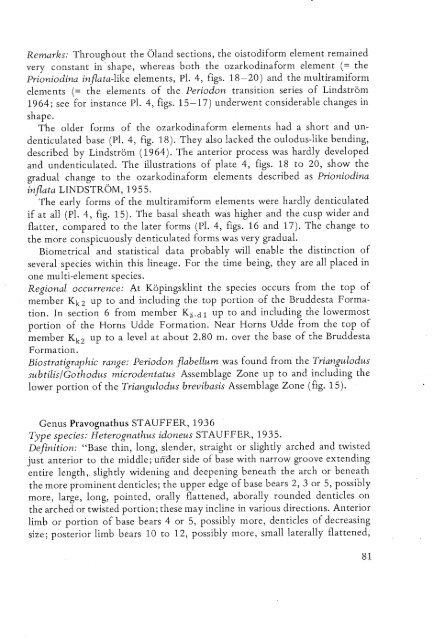UTRECHT MICROPALEONTOLOGICAL BUllETINS
UTRECHT MICROPALEONTOLOGICAL BUllETINS
UTRECHT MICROPALEONTOLOGICAL BUllETINS
You also want an ePaper? Increase the reach of your titles
YUMPU automatically turns print PDFs into web optimized ePapers that Google loves.
Remarks: Throughout the Oland sections, the oistodiform element remained<br />
very constant in· shape, whereas both the ozarkodinaform element (= the<br />
Prioniodina inflata-like elements, Pl. 4, figs. 18~20) and the multiramiform<br />
elements (= the elements of the Periodon transition series of Lindstrom<br />
1964; see for instance Pl. 4, figs. 15-17) underwent considerable changes in<br />
shape.<br />
The older forms of the ozarkodinaform elements had a short and undenticulated<br />
base (Pl. 4, fig. 18). They also lacked the oulodus-like bending,<br />
described by Lindstrom (1964). The anterior process was hardly developed<br />
and undenticulated. The illustrations of plate 4, figs. 18 to 20, show the<br />
gradual change to the ozarkodinaform elements described as Prioniodina<br />
inflata LINDSTROM, 1955.<br />
The early forms of the multiramiform elements were hardly denticulated<br />
if at all (Pl. 4, fig. 15). The basal sheath was higher and the cusp wider and<br />
flatter, compared to the later forms (Pl. 4, figs. 16 and 17). The change to<br />
the more conspicuously denticulated forms was very gradual.<br />
Biometrical and statistical data probably will enable the distinction of<br />
several species within this lineage. For the time being, they are all placed in<br />
one multi-element species.<br />
Regional occurrence: At Kopingsklint the species occurs from the top of<br />
member K k2 up to and including the top portion of the Bruddesta Formation.<br />
In section 6 from member Ka- d 1 up to and including the lowermost<br />
portion of the Horns Udde Formation. Near Horns Udde from the top of<br />
member K k2<br />
up to a level at about 2.80 m. over the base of the Bruddesta<br />
Formation.<br />
Biostratigraphic range: Periodon flabellum was found from the Triangulodus<br />
SlAbtilis/Gothodus microdentatus Assemblage Zone up to and including the<br />
lower portion of the Triangulodus brevibasis Assemblage Zone (fig. 15).<br />
Genus Pravognathus STAUFFER, 1936<br />
Type species: Heterognathus idoneus STAUFFER, 1935.<br />
Definition: "Base thin, long, slender, straight or slightly arched and twisted<br />
just anterior to the middle; lintler side of base with narrow groove extending<br />
entire length,. slightly widening and deepening beneath the arch or beneath<br />
the more prominent denticles; the upper edge of base bears 2, 3 or 5, possibly<br />
more, large, long, pointed, orally flattened, aborally rounded denticles on<br />
the arched or twisted portion; these may incline in various directions. Anterior<br />
limb or portion of base bears 4 or 5, possibly more, denticles of decreasing<br />
size; posterior limb bears 10 to 12, possibly more, small laterally flattened,
















